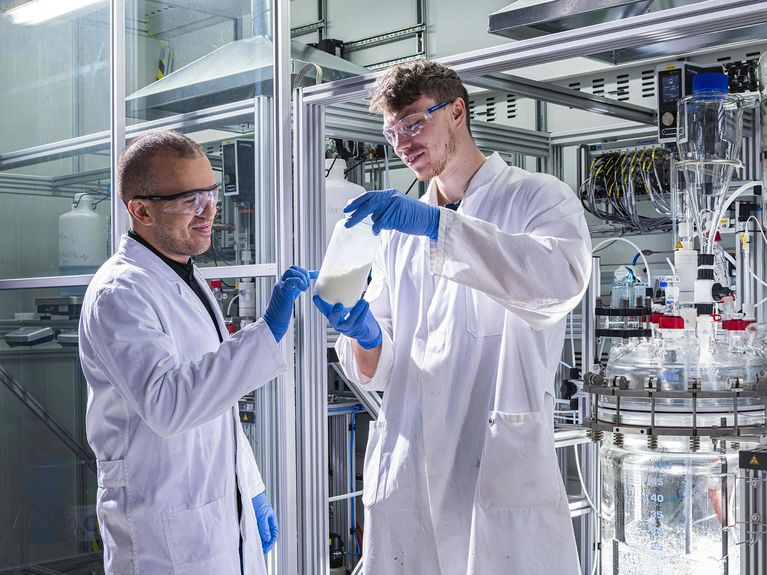
Story #18
Innovative Energy Storage: The Key to a Climate-neutral Future
What’s the best way to store energy? Whether cutting-edge batteries, hydrogen, or innovative high-temperature technologies – the experts at Helmholtz are working together to develop high-performance and resource-conserving solutions for the energy system of tomorrow.
Over the past few years, the energy transition has gained momentum: according to the regulatory authority Bundesnetzagentur, in 2024 the percentage of renewable energies in German power production rose to 59 percent – and other European countries are following suit. But the more that fluctuating amounts of wind and solar energy are fed into the grid, the more flexibility is called for. Given the simultaneous transformation of mobility and industrial production, energy storage solutions will be the key to a climate-neutral future – and have long-since become a matter of technological and industrial sovereignty in Germany and Europe.
The race to find the battery of tomorrow
The research centers of the Helmholtz Association are key players in driving the development of suitable storage technologies. In this regard, they pursue a range of approaches, since no single technology is flexible enough to meet all requirements. In the race to find the battery of tomorrow, Helmholtz is looking e.g. for sustainable, safe and affordable alternatives to the tried and true lithium-ion battery – and is therefore part of various research initiatives, a small sampling of which we present below.
For example, Karlsruhe Institute of Technology (KIT) is working to develop a sodium-ion battery that can be affordably manufactured in Europe using widely available materials, and helping industry set up corresponding production facilities.
In turn, Forschungszentrum Jülich is developing solid-state batteries, which contain no liquid electrolytes, making them an especially compact, safe and high-performance alternative. Other battery types are also being explored, e.g. metal-air batteries, which draw on oxygen absorbed from the air – which should theoretically afford them a high energy density, i.e., a high storage capacity with low weight.
Lastly, Helmholtz-Zentrum Berlin (HZB) is investigating metal-sulfur batteries, which, given their low weight, could be especially lucrative for electric vehicles. Here, one focus area involves operando analyses using the X-ray source BESSY II. HZB teams are also working on a completely new class of materials: the MXenes, which allow electrical charges to be stored at high speed – a major advantage for a range of engineering applications.
Hydrogen for medium- and long-term storage
Batteries are fast, flexible, and ideal for mobile applications. But when it comes to storing large amounts of energy – e.g. seasonal storage for solar energy collected in summer – green hydrogen is the best choice: it can store energy for extended periods without degradation and be burned emissions-free. In addition, hydrogen is a key raw material for industrial applications. It has the potential to bring together various energy sectors, replace fossil fuels and, as a component of synthetic fuels, make air and shipping traffic climate-friendlier in the long term. The research centers of the Helmholtz Association are vital drivers for innovation in Germany – more than 600 employees at ten Helmholtz Centers are pursuing research on the entire value chain, from production to transport and end users.
For example, the experts at Forschungszentrum Jülich are developing high-performance electrolyzers and working on hydrogen-based storage technologies, e.g. for bonding hydrogen to the organic carrier liquid LOHC – an approach that would allow us to continue using the existing infrastructure for liquid fuels. In turn, the HZB is concentrating on catalysts that can make both the production and conversion of hydrogen more efficient. KIT is exploring high-tech pipelines, storage tanks and conversion technologies, e.g. to transform hydrogen into synthetic methane, which can then be fed into the natural gas grid. The German Aerospace Center (DLR) is investigating the use of hydrogen as an emissions-free aviation fuel, while the GFZ Helmholtz Centre for Geosciences is looking into hydrogen storage in geological structures for major industrial applications on the Terawatt scale.
High-temperature thermal energy storage as an efficiency booster
Besides electrical and hydrogen storage, thermal energy storage systems are essential to efficiently using renewable energies. High-temperature systems allow industry to store and reuse process heat from renewable sources or exhaust heat from e.g. production facilities, paving the way for substantial efficiency gains. Once scaled, this technology can be used with existing regional heating grids and, coupled with existing steam power plants, even be used to generate the base load. Here, too, Helmholtz is leading the way: KIT is developing high-temperature long-term thermal energy storage systems using liquid metals and ceramics, while the DLR is focusing on molten salt, which can serve as a buffer for concentrated solar energy and allow direct coupling with renewable energy sources.
Bild: KIT/Markus Breig